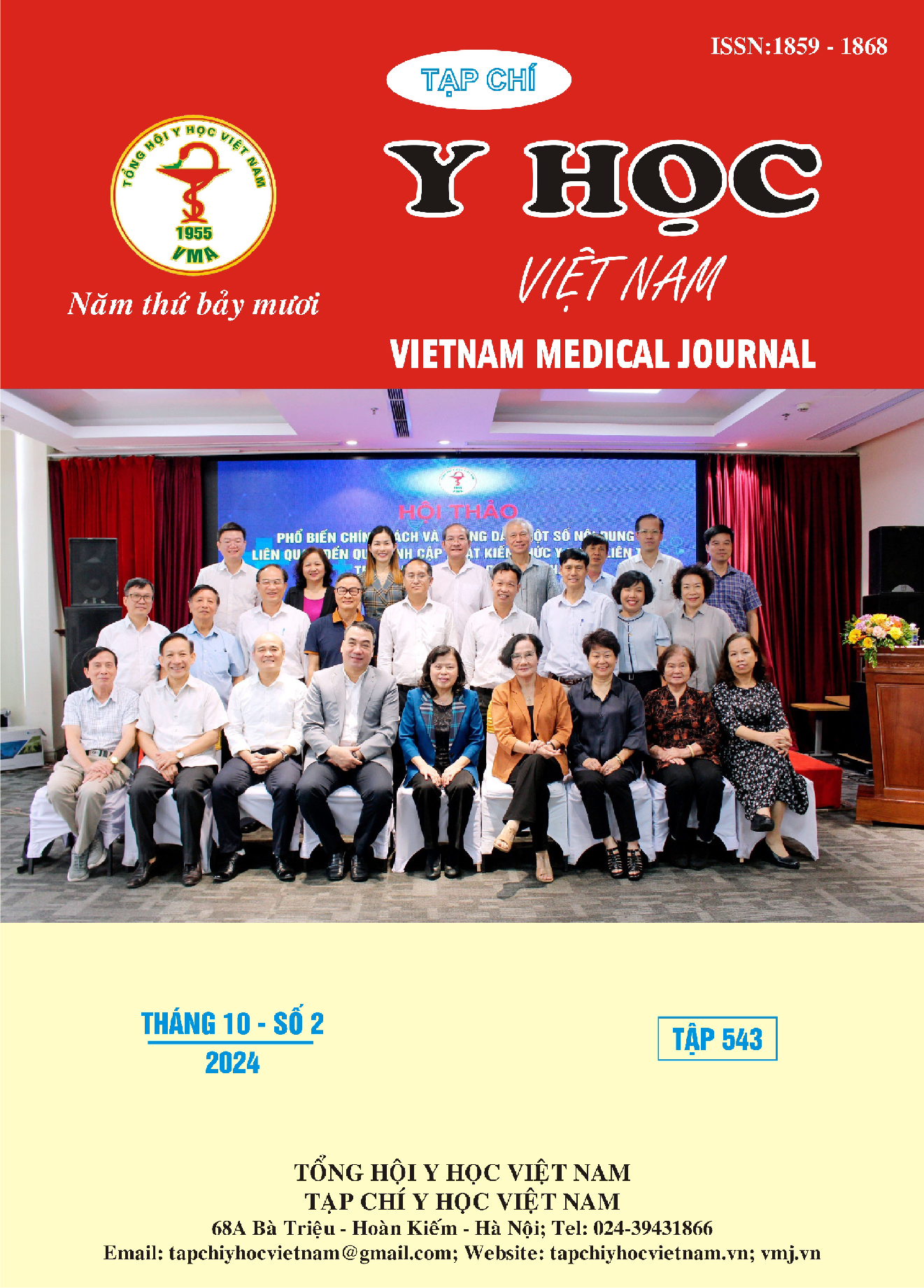EARLY EVALUATION OF NASOLACRIMAL PROBING WITH MASTERKA OR NUNCHAKU STENTING IN TREATMENT OF CONGENITAL NASOLACRIMAL DUCT OBSTRUCTION
Main Article Content
Abstract
Background: Congenital nasolacrimal duct obstruction (CNLDO) is a common condition in infants, with an incidence ranging from 5% to 20%. While many cases resolve spontaneously or respond to conservative treatments such as lacrimal sac massage and antibiotics, surgical intervention becomes necessary for cases persisting beyond 12 months of age. Traditional treatments like dacryocystorhinostomy (DCR) with silicone tube placement have shown effectiveness but are associated with a high recurrence rate and potential complications such as nasal mucosal injury and postoperative bleeding. Objective: This study aims to evaluate the effectiveness and safety of two new lacrimal stent types, Masterka and Nunchaku, in the treatment of CNLDO. Methods: A prospective study was conducted on 20 pediatric patients at Ho Chi Minh City Eye Hospital, with 12 patients treated using the Masterka stent and 8 patients treated using the Nunchaku stent. Patients were monitored and evaluated at 1 day, 1 month, 3 months, 6 months, and 9 months post-operation. Results: The success rate post-operation was 100% in both groups, with no significant complications reported. The average surgery time was 4 minutes for the Masterka group and 9 minutes for the Nunchaku group. All parents expressed satisfaction with the surgical outcomes, and no recurrences were observed after 6 months of follow-up. Conclusion: Both the Masterka and Nunchaku tubes proved to be highly effective and safe in treating CNLDO, with excellent success rates and no significant complications. These findings suggest that these methods could be widely adopted in clinical practice.
Article Details
Keywords
CNLDO, probing, Masterka, Nunchaku
References
2. Hung CH, Chen YC, Lin SL, Chen WL. Nasolacrimal Duct Probing under Topical Anesthesia for Congenital Nasolacrimal Duct Obstruction in Taiwan. Pediatr Neonatol. Dec 2015;56(6): 402-7. doi:10.1016/j.pedneo. 2015.04.001
3. Petris C, Liu D. Probing for congenital nasolacrimal duct obstruction. Cochrane Database Syst Rev. Jul 12 2017;7(7):CD011109. doi:10.1002/14651858.CD011109.pub2
4. Robb RM. Probing and irrigation for congenital nasolacrimal duct obstruction. Arch Ophthalmol. Mar 1986;104(3): 378-9. doi:10.1001/archopht. 1986.01050150078031
5. Lee H, Ahn J, Lee JM, Park M, Baek S. Clinical effectiveness of monocanalicular and bicanalicular silicone intubation for congenital nasolacrimal duct obstruction. J Craniofac Surg. Jul 2012; 23(4): 1010-4. doi:10.1097/SCS. 0b013e31824dfc8a
6. Vernat-Tabarly O, Delmas J, Robert PY. [Congenital nasolacrymal duct obstruction: pulled monocanalicular intubation (Monoka) versus pushed monocanalicular intubation (Masterka)]. J Fr Ophtalmol. Jun 2020;43(6):461-466. Impermeabilite lacrymonasale simple de l'enfant: comparaison entre une intubation monocanaliculaire << tiree >> type Monoka versus intubation monocanaliculaire << poussee >> type Masterka. doi:10.1016/j.jfo.2019.10.016
7. Khatib L, Nazemzadeh M, Revere K, Katowitz WR, Katowitz JA. Use of the Masterka for complex nasolacrimal duct obstruction in children. J AAPOS. Oct 2017;21(5): 380-383. doi:10.1016/j.jaapos.2017.05.033
8. Chi YC, Lai CC. Endoscopic dacryocystorhinostomy with short-term, pushed-type bicanalicular intubation vs. pulled-type monocanalicular intubation for primary acquired nasolacrimal duct obstruction. Front Med (Lausanne). 2022;9: 946083. doi:10.3389/fmed. 2022.946083
9. Mimura M, Ueki M, Oku H, Sato B, Ikeda T. Indications for and effects of Nunchaku-style silicone tube intubation for primary acquired lacrimal drainage obstruction. Jpn J Ophthalmol. Jul 2015;59(4):266-72. doi:10.1007/s10384-015-0381-5
10. Zimmermann JA, Storp JJ, Merte RL, Lahme L, Eter N. Retrospective Analysis of Bicanalicular Lacrimal Silicone Tube Intubation in Patients with Congenital Nasolacrimal Duct Obstruction: A Long-term Follow-up Study. Klin Monbl Augenheilkd. Apr 26 2024;Retrospektive Analyse der bikanalikularen Tranenwegsintubation bei angeborener Tranenwegsstenose: eine Langzeitstudie. doi:10.1055/a-2237-1139.


